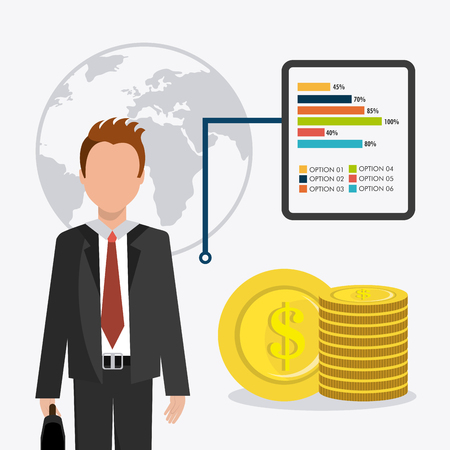1. Understanding Inflation and Its Economic Impact
Inflation is the rate at which the general level of prices for goods and services rises, eroding purchasing power over time. When inflation occurs, each dollar buys fewer goods and services, which can significantly impact consumers, businesses, and investors.
How Inflation Affects Purchasing Power
Purchasing power refers to the amount of goods or services that a unit of currency can buy. As inflation increases, the value of money decreases, meaning that consumers need more money to purchase the same items. This can lead to reduced consumer spending and shifts in buying behavior.
Impact on Interest Rates
Central banks, such as the Federal Reserve in the U.S., use interest rates to control inflation. When inflation rises, central banks often increase interest rates to slow down economic activity and reduce price pressures. Higher interest rates make borrowing more expensive, affecting everything from mortgages to business loans.
Effects on Overall Economic Growth
Inflation can have mixed effects on economic growth:
| Inflation Level | Economic Impact |
|---|---|
| Moderate Inflation (2-3%) | Encourages spending and investment, supporting economic growth. |
| High Inflation (>5%) | Erodes consumer confidence, reduces savings value, and slows economic expansion. |
| Hyperinflation (>50% per month) | Severely disrupts economies, leading to currency devaluation and financial instability. |
Key Takeaways on Inflation’s Economic Impact
(1) Declining Purchasing Power
The rising cost of goods means consumers can afford less with the same income.
(2) Higher Borrowing Costs
Banks raise interest rates, making loans more expensive for individuals and businesses.
(3) Uncertainty in Investments
Investors may shift towards assets that traditionally perform well during inflationary periods, such as commodities or real estate.
2. Impact of Inflation on Key Economic Sectors
Inflation affects various industries in different ways. Some sectors may benefit from rising prices, while others struggle with higher costs and reduced consumer purchasing power. Lets take a closer look at how inflation influences key economic sectors such as consumer goods, real estate, technology, and healthcare.
Consumer Goods
The consumer goods sector is directly impacted by inflation as rising costs of raw materials and transportation lead to higher product prices. Consumers may reduce discretionary spending, affecting companies that rely on non-essential goods.
Key Effects:
- Higher production costs due to increased prices of raw materials.
- Reduced consumer demand for non-essential items.
- Potential for businesses to pass costs onto consumers, leading to price hikes.
Real Estate
The real estate market often experiences both positive and negative effects from inflation. While property values tend to rise, higher mortgage rates can impact affordability.
Key Effects:
- Property values generally increase during inflationary periods.
- Higher interest rates make borrowing more expensive, slowing home purchases.
- Rental income often rises as landlords adjust for inflation.
Technology
The technology sector faces unique challenges during inflationary periods. While some tech companies benefit from pricing power, others struggle with rising labor and material costs.
Key Effects:
- Salaries for skilled workers may increase, adding to operational costs.
- Semi-conductor and hardware manufacturers face higher component prices.
- SaaS (Software-as-a-Service) companies may maintain stable revenue streams through subscriptions.
Healthcare
The healthcare industry is somewhat shielded from inflation due to the essential nature of medical services. However, rising costs still impact hospitals, pharmaceutical companies, and insurance providers.
Key Effects:
- The cost of medical supplies and pharmaceuticals rises.
- Health insurance premiums increase to account for higher expenses.
- Aging populations drive consistent demand for healthcare services despite inflation.
Summary of Inflation’s Impact Across Sectors
| Sectors | Main Impact of Inflation |
|---|---|
| Consumer Goods | Higher production costs; reduced discretionary spending. |
| Real Estate | Rising property values; increased mortgage rates affect affordability. |
| Technology | Salaries rise; hardware production costs increase; subscription models provide stability. |
| Healthcare | The cost of medical supplies increases; consistent demand ensures stability. |

3. Stock Market Reactions to Inflation
Inflation has a direct impact on the stock market, influencing stock prices, corporate earnings, and investor sentiment. Some sectors benefit from inflationary periods, while others struggle. Understanding these dynamics can help investors make informed decisions.
How Inflation Affects Stock Prices
Stock prices fluctuate based on inflation expectations and actual inflation rates. Higher inflation often leads to increased interest rates, which can reduce the present value of future earnings and negatively impact stock valuations.
(1) Interest Rates and Stock Valuations
When inflation rises, central banks like the Federal Reserve may increase interest rates to control it. Higher interest rates lead to higher borrowing costs for companies, potentially reducing their profitability and making stocks less attractive compared to fixed-income investments.
(2) Purchasing Power and Consumer Spending
Inflation affects consumer purchasing power. When prices rise faster than wages, consumers may cut back on discretionary spending, impacting companies that rely on consumer demand, such as retail and travel industries.
Impact on Corporate Earnings
Inflation can influence corporate earnings in different ways depending on the industry.
| Sector | Effect of Inflation on Earnings |
|---|---|
| Technology | Higher borrowing costs may slow expansion; lower consumer demand for expensive gadgets. |
| Consumer Staples | Essential goods maintain demand; companies may pass higher costs to consumers. |
| Energy | Tends to benefit as oil and gas prices rise with inflation. |
| Financials | Banks may profit from rising interest rates due to higher loan margins. |
| Real Estate | Mixed effects—rising property values benefit landlords, but higher mortgage rates can reduce demand. |
Investor Sentiment During Inflationary Periods
The stock market is heavily influenced by investor sentiment, which can shift dramatically during inflationary periods.
(1) Increased Market Volatility
Uncertainty about inflation trends and Federal Reserve actions can create market volatility. Investors may react strongly to economic data releases, leading to rapid price swings.
(2) Shift Towards Defensive Stocks
During high inflation, investors often move toward defensive sectors such as healthcare, utilities, and consumer staples. These industries provide essential products and services that remain in demand regardless of economic conditions.
(3) Growth vs. Value Stocks
Growth stocks, especially in technology, tend to suffer in high-inflation environments due to higher discount rates applied to future earnings. In contrast, value stocks with strong cash flows and pricing power often perform better.
4. Fixed Income Investments and Inflation Risks
Inflation poses a significant challenge for fixed income investments, particularly bonds. Since bond yields are typically fixed, rising inflation reduces their purchasing power over time. This means that investors receiving fixed interest payments may find their real returns diminishing as the cost of goods and services increases.
How Inflation Erodes Bond Yields
Bonds provide a predictable income stream, but inflation can eat away at those returns. Here’s how:
- Reduced Purchasing Power: If inflation rises above a bond’s yield, the real return becomes negative.
- Higher Interest Rates: Central banks may raise interest rates to combat inflation, causing existing bonds with lower yields to lose value.
- Market Demand Shifts: Investors may shift to assets that offer better inflation protection, reducing demand for traditional bonds.
The Role of TIPS in Mitigating Inflation Risks
Treasury Inflation-Protected Securities (TIPS) are designed to help investors safeguard their portfolios against inflation. Unlike traditional bonds, TIPS adjust their principal value based on changes in the Consumer Price Index (CPI), ensuring that both the principal and interest payments keep pace with inflation.
Key Benefits of TIPS
- Inflation Adjustment: The principal amount increases with inflation, helping maintain purchasing power.
- Interest Payments Grow: Since interest is calculated on the adjusted principal, payments rise when inflation increases.
- Government Backing: As U.S. Treasury securities, TIPS carry minimal credit risk.
Comparing Traditional Bonds vs. TIPS
| Feature | Traditional Bonds | TIPS |
|---|---|---|
| Principal Adjustment | Fixed | Adjusted for inflation |
| Interest Payments | Fixed rate on initial principal | Variable (based on adjusted principal) |
| Inflation Protection | No direct protection | Designed to counteract inflation |
| Market Sensitivity | Affected by rising rates and inflation | Less impacted by inflation concerns |
(1) When to Consider TIPS?
If you expect inflation to rise or want to diversify your portfolio with an inflation-protected asset, TIPS could be a smart addition. They work well in environments where inflation uncertainty is high and traditional fixed-income assets face declining real returns.
(2) Balancing Fixed Income Investments
A well-rounded investment strategy might include both traditional bonds and TIPS. While TIPS protect against inflation, traditional bonds can still be valuable in periods of stable or declining inflation.
Understanding the relationship between inflation and fixed income investments helps investors make informed decisions about balancing risk and returns in their portfolios.
5. Investment Strategies to Hedge Against Inflation
Inflation can erode purchasing power and impact investments across various sectors. To safeguard wealth, investors should consider strategies that provide protection against rising prices. Below are key investment options that can help hedge against inflation.
Commodities: A Traditional Inflation Hedge
Commodities, such as gold, oil, and agricultural products, often rise in value during inflationary periods. These tangible assets typically maintain their worth when fiat currency loses its purchasing power.
(1) Gold and Precious Metals
Gold has historically been a safe haven during economic uncertainty and inflationary periods. Investors can buy physical gold, exchange-traded funds (ETFs), or gold mining stocks.
(2) Energy and Agricultural Commodities
Oil, natural gas, and agricultural products tend to appreciate with inflation because they are essential goods with increasing demand.
Real Estate: A Tangible Asset with Growth Potential
Real estate investments can act as an effective inflation hedge since property values and rental income typically increase over time.
(1) Residential and Commercial Properties
Owning rental properties provides a steady income stream while property values generally rise alongside inflation.
(2) Real Estate Investment Trusts (REITs)
REITs allow investors to gain exposure to real estate without directly owning properties. They offer potential for appreciation and dividend income.
Inflation-Protected Securities: Preserving Purchasing Power
Inflation-protected securities adjust their value based on inflation rates, ensuring that the investment retains purchasing power.
(1) Treasury Inflation-Protected Securities (TIPS)
TIPS are U.S. government bonds that adjust with inflation, making them a low-risk option for preserving capital.
(2) Inflation-Linked Bonds
Many countries offer bonds linked to inflation indexes, providing similar benefits as TIPS.
Diversified Portfolios: Spreading Risk Across Asset Classes
A well-diversified portfolio balances different asset classes to mitigate risks associated with inflation.
| Asset Class | Inflation Protection Level | Risk Level |
|---|---|---|
| Commodities (Gold, Oil, Agriculture) | High | Medium-High |
| Real Estate (Properties, REITs) | Moderate-High | Medium |
| TIPS & Inflation-Linked Bonds | High | Low |
| Diversified Stock Portfolio (Dividend Stocks, Growth Stocks) | Moderate | Medium-High |
(1) Dividend-Paying Stocks
Companies that consistently pay dividends tend to perform well during inflationary periods by passing costs onto consumers.
(2) Growth Stocks in Essential Industries
Sectors like healthcare, technology, and consumer staples often continue growing despite rising prices.
Diversifying across multiple asset classes ensures a balanced approach to managing inflation risks while optimizing potential returns.


